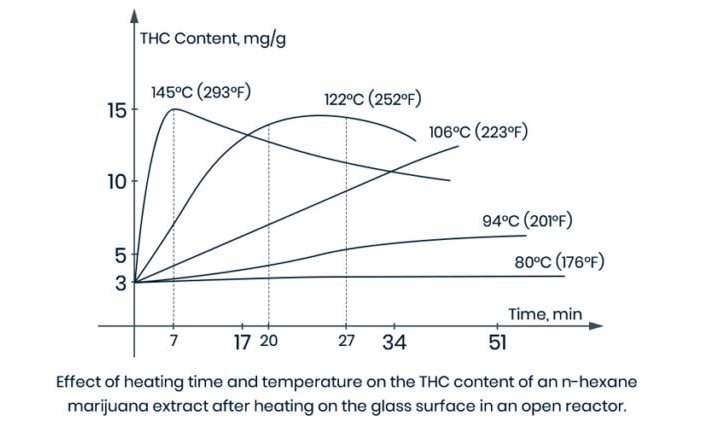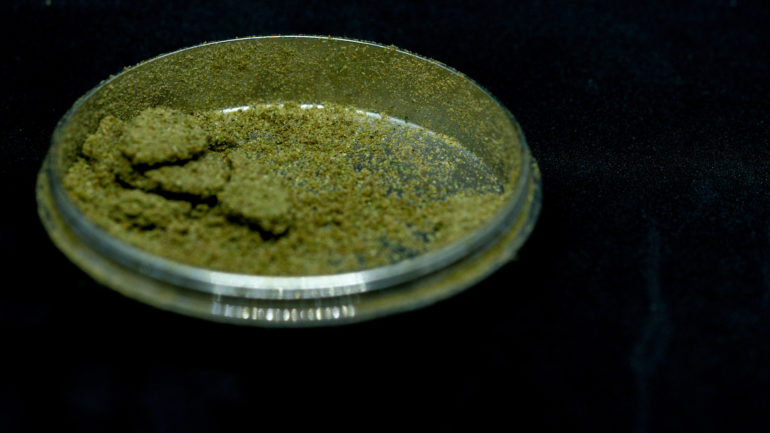Decarbing your cannabis is a crucial step if you’re making edibles, but it’s one that’s often misunderstood. The process – and the reason for it – is confusing enough if you aren’t well-versed in the basics, but it might seem even more confusing for kief than for ordinary flower.
After all, isn’t kief pure cannabinoids? Why would you need to prepare it in any way before using it in edibles? And how would you do it?
The good news is that the process of decarboxylating your kief is basically the same as decarbing cannabis flower – just for a shorter period of time – and the reasoning behind it is also identical. So learning how to decarb kief is very straightforward and you’ll be ready to start cooking with kief in no time.
How to Decarb Kief (4 Steps)
The process for the decarboxylation of kief will be familiar enough if you’ve ever decarbed weed before, but the timing and temperature are slightly different. But aside from your kief and an oven-safe dish to use, all you’ll need is a couple of pieces of parchment paper.

Time needed: 30 minutes
- Collect Your Kief
If you’re using kief collected from a grinder, this step will have already been done for you. However, if necessary, you can rub cannabis onto a silk screen, with something to catch it underneath. Choose a screen with between 75 and 125 micron holes.
- Prepare Oven and Lay the Kief Out
Preheat your oven to 250 °F / 121 °C. It’s worth noting that your oven temperature can vary, and it will likely be hotter near the top than near the bottom. Generally it’s best to have a spot in the middle of the oven for your oven dish. Place a baking sheet/piece of parchment onto the oven-safe dish you’ve chosen.
A good tip is to crumple the sheet before you lay it out to keep as much of it as possible off the hotter oven dish surface. Try to spread the kief out as much as you can to give a roughly even exposure to heat for all of it, so there aren’t any notable piles or lumps in there. Additionally, you can lay another piece of parchment on top to trap any vapors in place and maximize the resulting potency. - Put the Dish in the Oven and Decarb
When your kief is spread out and your oven has reached the required temperature, you’re ready to start the process. Place the dish in the center of the oven and leave it there for around 25 minutes. The exact time depends on a number of factors, including the thickness of the kief layer and the precision of your oven.
You should check the kief after 20 minutes – it will darken a little in color, but if it looks like it’s too brown you should remove it. Unfortunately this is difficult to judge, so the best advice is to leave it 25 minutes on your first try unless you have a very small amount of kief or you’ve put it high up in the oven. This will give you an idea of what it should look like when it’s done, and then you can judge in future based on this. - Remove the Dish and Let it Cool
When the kief is decarboxylated, remove the dish from the oven. It’s a good idea to take the parchment off the hot dish (carefully!) to prevent it from continuing to cook. Remember, heating too much can decrease the percentage of THC in the final mix. When it’s cool – which doesn’t take long with kief – you can go ahead and use it in whatever recipe you’re making.
Different Temperatures and Data on the Decarboxylation of Kief
If you’re looking around online for how to decarboxylate kief, you’ll undoubtedly spot some conflicting advice. Some sources recommend a lower temperature for a longer period of time, and this is also totally fine. The chart below basically sums up the issue.

At high temperatures, the amount of THC rises sharply and quickly but then starts to decline quickly as well. Lower temperatures smooth out the curve at the expense of taking a little longer.
Our approach – 250 °F for 25 minutes – is a good balance between being forgiving if you over-shoot but not taking excessive amounts of time. However, if you’d rather go lower and slower than can also work – some sites suggest you can do 220 °F (104 °C) for 45 to 50 minutes, for example.
Marijuana Growers HQ did some testing and found that for kief, the THC percentage rose from 3.8% to 25.4% after a 30 minute decarb at 240 °F, only increasing a fraction of a percent after an extra 30 minutes. In short, this shows that you’re unlikely to need longer with kief. In contrast, for plant material there was a substantial increase in THC levels for up to an hour.
How to Decarb Hash
Decarbing hash is basically the same process as decarbing kief. The main challenge is breaking up the hash into small pieces, but once you’ve done this – at least consistently – you go through the process described above. If you have a high-CBD strain, it’s better to decarb it for a little longer. Around 40 minutes will give the CBDA time to convert.
What is Kief?
Kief is essentially a powdery form of the trichomes, which are the glands on the cannabis plant containing the THC, CBD and other cannabinoids. Many grinders have “kief catchers” for the purpose of catching it, since the process of breaking apart the cannabis also breaks off a lot of the trichomes. In “kief” form they’re dry and have generally been sifted through a fine mesh screen.
The kief itself is darker than the trichomes on the plant, with a golden to brown color, or even with hints of green because of leftover plant matter. Generally, it’s purer if it’s lighter in color, but you’ll still get good results even if the kief you use isn’t perfect.
Why You Should Decarb Before Cooking with Kief
Decarboxylation is a crucial step in making edibles because it converts the THC, CBD and other cannabinoids into a usable form.
In the plant – and in the kief that breaks off from it – THC exists as THCA, CBD as CBDA and so on. These are acid forms of the molecules, and basically contain an extra carboxyl group. “Decarbing” means to remove this extra group, producing the forms of the chemicals that have the desired effect when you eat it.
Technically, the process of vaporizing or smoking herb also decarbs it as you inhale. This is why you don’t have to decarb weed or kief if you’re just smoking or vaping it. However, if you’re making edibles or cannabutter, you have to ensure the cannabis is ready-to-go before you put it into a recipe.
The process is always the same, though: you add heat for the decarboxylation of kief or cannabis flower. But things become a bit more complicated if you want to maximize the efficiency.
While kief or cannabis will decarb quicker at higher temperatures, after you reach the optimal point, the potency will actually decrease with longer in the heat. Because of this, you should follow instructions for how to decarboxylate kief carefully.
Conclusion – Enjoy Cooking with Kief
Once you’ve decarboxylated kief, it’s ready to use however you want. Cooking with kief is a very convenient way of making edibles because it’s more compact and concentrated than flower, and imparts less flavor – although still some – into your dishes. The powdery consistency also opens up other options for cooking, including incorporating kief into seasoning mixes. However you’re intending on using your kief, as long as it’s decarbed, you’re good to go.
